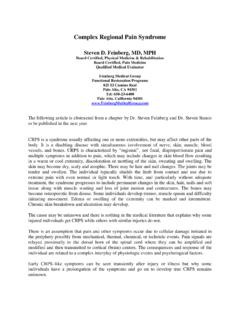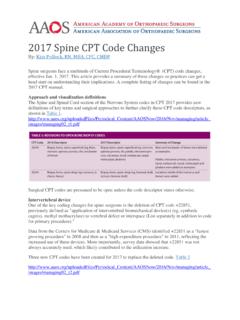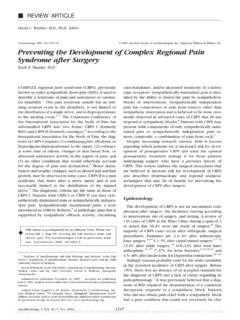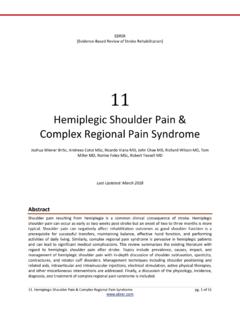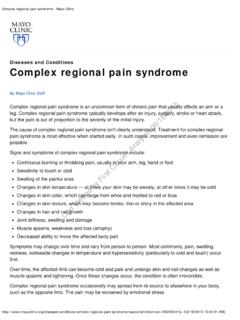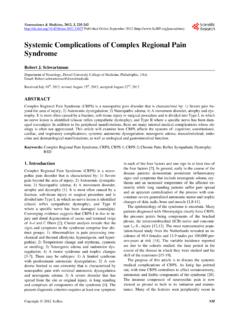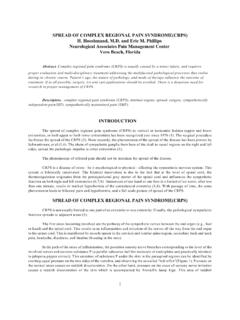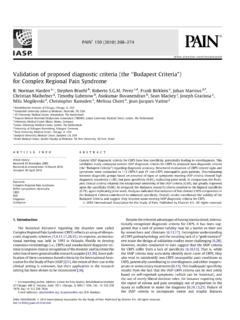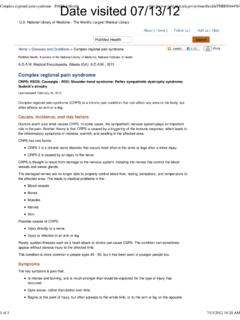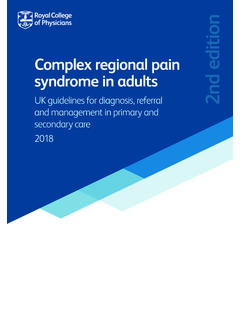Transcription of STEVEN D. FEINBERG, MD, MPH
1 STEVEN D. feinberg , MD, MPH Board Certified, Physical Medicine & Rehabilitation Board Certified, pain Medicine Qualified Medical Evaluator Adjunct Clinical Professor, Stanford School of Medicine feinberg Medical Group Functional Restoration Programs Palo Alto, California 94301 Rating complex regional pain syndrome (CRPS) What Does the AMA Guides Say? What is CRPS? The term CRPS is meant as a descriptor no assumptions about pathophysiology CRPS is a syndrome patient's symptoms and signs match criteria CRPS is Uncommon most patients with widespread pain in an extremity do NOT have CRPS more appropriate to describe a patient as having " regional pain of undetermined origin" CRPS Definitions CRPS Type I (RSD) Usually develops after an initiating noxious event Not limited to the distribution of a single peripheral nerve pain disproportionate to the inciting event CRPS Type II (causalgia)
2 Follows partial injury to a nerve CRPS usually develops within days to months of the inciting event (with exceptions!) CRPS Presentation Significant pain complaints limbs mostly but may involve other body parts Changes in skin blood flow warm or cool extremity discoloration, mottling, sweating and swelling Limb shielded from contact and use Progresses to: skin ( d r y, scaly, atrophic), hair & nail changes joint tenderness and swelling muscle wasting and loss of motion, tremor CRPS Etiology Cause: why some and not others? No obvious etiology Nerve injury or minor trauma Orthopedic patients post-operatively, after stroke or head trauma and following myocardial infarction, chest surgery or infection Reported with cancer, arthritis, burns, nerve entrapments, herpes zoster ( shingles ) Evaluation & Diagnosis H&P most important tool in the diagnosis inspection, palpation, range of motion musculoskeletal and neurologic examination Special attention is paid to temp measurements, sensation, skin coloration, hair & nail changes, swelling & surface moisture (sweat) Radiologic studies.
3 X-ray & bone scan Negative studies do not rule out CRPS Psychological testing & evaluation Treatment Approach Early diagnosis should be followed by a multi-faceted program involving: blockade of sympathetic hyperactivity physical rehabilitation psychological care Education medication optimization invasive procedures, as appropriate functional restoration CRPS Diagnosis Disease awareness & clinical observation Classical symptoms unusual Early stages: subjectives > objectives Symptoms can wax & wane Patient history & medical record important Evaluate the patient on multiple occasions Evaluation complicated by RSD education CRPS Diagnosis Initial precipitating event may be trivial May not be remembered by the patient Tests/Procedures to confirm the diagnosis X-ray, bone scan or sympathetic nerve block A negative result does not rule out the condition Disease often relentlessly progressive with increasing discomfort, disability & dysfunction Symptom spread proximally & to other limbs CRPS Differential Diagnosis Swollen leg(s)
4 Due to venous clot or CHF Cold limb 2o to arterial blockage/PVD/Raunaud s Swollen arm due to breast tumor spreading to lymph glands in the axillary area Infection of skin (cellulitis) and bone (osteomyelitis) presenting in similar fashion HNP with nerve root impingement (radiculopathy) or carpal tunnel syndrome presenting with CRPS component neuropathic pain Clinical Criteria for CRPS Continuing pain , which is disproportionate to any inciting event Must report at least one symptom in 3 of the 4 following categories: Sensory: Reports of hyperesthesia and/or allodynia Vasomotor: Reports of temperature asymmetry and/or skin color changes and/or skin color asymmetry Sudomotor/Edema: Reports of edema and/or sweating changes and/or sweating asymmetry Motor/Trophic: Reports of decreased range of motion and/or motor dysfunction (weakness, tremor, dystonia) and/or trophic changes (hair, nail, skin) Clinical Criteria for CRPS Must display at least one sign at time of evaluation in two or more of the following categories: Sensory: Evidence of hyperalgesia (to pinprick) and/or allodynia (to light touch and/or temperature sensation and/or deep somatic pressure and/or joint movement) Vasomotor.
5 Evidence of temperature asymmetry (> 1 C) and/or skin color changes and/or asymmetry Sudomotor/Edema: Evidence of edema and/or sweating changes and/or sweating asymmetry Motor/Trophic: Evidence of decreased range of motion and/or motor dysfunction (weakness, tremor, dystonia) and/or trophic changes (hair, nail, skin) Clinical Criteria for CRPS There is no other diagnosis that better explains the signs and symptoms AMA Guides 5th Edition Chapter 13, The Central and Peripheral Nervous System ( Criteria for Rating Impairments Related to Chronic pain , page 343) Chapter 16, The Upper Extremities ( complex regional pain Syndromes (CRPS), Reflex Sympathetic Dystrophy (CRPS I), and Causalgia (CRPS II) Chapter 17 The Lower Extremities (the evaluator is told to use Chapter 13) Chapter 13.)
6 The Central and Peripheral Nervous System Table 13-22, Criteria for Rating Impairment Related to Chronic pain in One Upper Extremity Tables 13-15, Criteria for Rating Impairments Due to Station and Gait Disorders These Tables are functionally based Upper Extremity Impairment Station & Gait Disorders Chapter 16: The Upper Extremities For upper extremity complex regional pain Syndromes (CRPS), Reflex Sympathetic Dystrophy (CRPS I), and Causalgia (CRPS II), Section (5th ed., 495-497) is used which relies on anatomical changes to define impairment Chapter 16 requires objective findings to rate complex regional pain syndrome (CRPS) as presented in Table 16-16 (5th ed.)
7 , 496) outdated criteria Calculating the WPI Chapter 16 Type I: RSD (neither the initiating cause nor the symptoms involve a specific peripheral nerve structure or territory) joint ROM loss of involved joints impairment resulting from sensory deficits and pain according to the grade that best describes the severity of interference with ADLS 1 & 2 values for sensory and motor deficits of a specific nerve structure cannot be applied additional impairment is assigned for decreased pinch or grasp strength impairment rating method described for sensory deficits due to lesions of digital nerves is not applied in CRPS Calculating the WPI Chapter 16 Type II.
8 Causalgia (a specific sensory or mixed nerve structure is involved) joint ROM loss of involved joints impairment resulting from sensory deficits and pain according to the grade that best describes the severity of interference with ADLS the impairment resulting from motor deficits and loss of power of the injured nerve 1, 2 & 3 additional impairment is assigned for decreased pinch or grasp strength impairment rating method described for sensory deficits due to lesions of digital nerves is not applied in CRPS Williams Case AME used Section of AMA Guides, rather than Section , to determine applicant's resulting impairment based on applicant's activities of daily living deficit in upper extremity and loss of use of his right arm Williams Case WCAB held that AMEs opinion constituted substantial evidence that IW suffered CRPS resulting in 75% PD AME diagnosed CRPS based on 40 years of medical experience, his medical training, applicant's history, and physical examination Williams Case AME discussed why he believed diagnostic criteria in Section regarding CRPS syndrome were outdated.
9 And explained that Section more accurately reflected applicant's impairment Williams Case WCAB found that nothing in Labor Code 4660 requires physicians to use AMA Guides for establishing diagnosis, only that physician use AMA Guides to find corresponding impairments based on their clinical findings, as was done by AME
